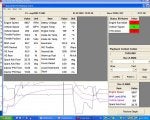Has anybody done Dyno runs to determine what the best AFR is for power?
I know that all NA engines make best power from 12.0 to 13.5:1. Generally older technology engines (less efficient) make best power at around 12.5:1. Newer technology engines are more efficient, and generally make the most power from 12.8 to 13.2:1. From reading the dozens of dyno charts in here it looks like the V-Rod makes the most power with an AFR of 13.0:1.
Has anybody actually tested the V-Rod at 12.9:1 or 13.1:1 to determine if this is infact true?
I will be in the process of getting a flat AFR for the following:
03 V-Rod
PC3r
SE/K&N airfilter
lid on
SE V-Modded pipes.
Current targets are:
11.5-12.5 Cold start (for the first 30 seconds)
13.0 Idle (0 and 2% Throttle Position)
14.7 cruise (5-20% Throttle Position)
13.0 WOT
smooth curve in the middle
like this
I know that all NA engines make best power from 12.0 to 13.5:1. Generally older technology engines (less efficient) make best power at around 12.5:1. Newer technology engines are more efficient, and generally make the most power from 12.8 to 13.2:1. From reading the dozens of dyno charts in here it looks like the V-Rod makes the most power with an AFR of 13.0:1.
Has anybody actually tested the V-Rod at 12.9:1 or 13.1:1 to determine if this is infact true?
I will be in the process of getting a flat AFR for the following:
03 V-Rod
PC3r
SE/K&N airfilter
lid on
SE V-Modded pipes.
Current targets are:
11.5-12.5 Cold start (for the first 30 seconds)
13.0 Idle (0 and 2% Throttle Position)
14.7 cruise (5-20% Throttle Position)
13.0 WOT
smooth curve in the middle
like this








